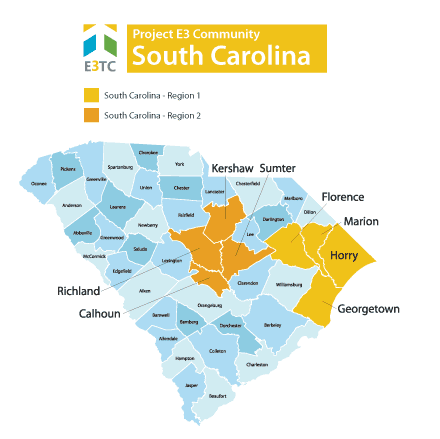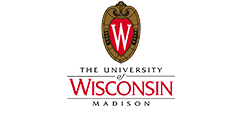South Carolina was chosen as a targeted community through the Vocational Rehabilitation Technical Assistance Center: Targeted Communities (VR-TAC-TC) or Project E3. Project E3 partnered with State VR Agencies and local community partners to improve outreach and employment-related services to underserved people with disabilities in these communities.

South Carolina is known for its 187 miles of coastline, beautiful lush gardens, historic sites and Southern plantations, and its growing economic development. The state’s Atlantic coastline is a popular destination for travelers. South Carolina is the 40th largest state in area and 23rd most populous state. Agriculture, including cotton, hay, and soybeans, as well as industry including textiles, chemical products, and paper products are important to the economy.
Targeted Communities
The state-federal vocational rehabilitation system in South Carolina faced many challenges as it strove to serve people with significant disabilities and promote competitive integrated employment. Project E3 provided intensive technical assistance to two regions of the state:

Key Information:
Vision Impairment
People Reporting Vision Difficulties
16,826
people in Pee Dee region
Poverty Rate
Disability Rate
National rate = 8.5%
Targeted Populations
These populations were characterized as:
Primary Challenges for Targeted Populations
Despite the provision of high quality vocational rehabilitation services, individuals with disabilities within the Pee Dee and Midlands regions continued to experience high poverty and high unemployment. These outcomes persisted due to numerous barriers that existed to engaging in and completing vocational rehabilitation programming. These barriers included:
Key Strategies to Address Barriers
Following are some of the key strategies developed and implemented to address the targeted populations' challenges and barriers to employment.
Community Based Participatory Research (CBPR): To understand a community’s issues and concerns, one needs data and information both supplied by common data sources and interpreted by the community to better understand their issues and possible solutions to those issues. CBPR’s methodology is predicated on deep and extensive community involvement in the identification of issues and concerns and in the resolution of those issues and concerns.
Motivational Interviewing: Project E3 provided 2 days of training to all SCCB VR Counselors and Supervisors. Training included an MI toolkit and materials. SCCB had invited community partners including the general agency to attend, but only SCCB VR staff ended up attending. Staff use selective techniques
Work Incentive Benefits Counseling: SC identified this as a key strategy to help clients understand the positive implications of pursing competitive employment and the effects on benefits. Referrals increased after the training and SCCB now uses the state WIPA grant program
Financial Literacy: SCCB modified and adapted the curriculum “Skills to Pay the Bills” to be used in the standard EBMRCE curriculum. In addition, SCCB reported that “Skills to Pay the Bills” has been incorporated into their Summer Teens program and was incorporated into the new BRIDGE Program. SCCB decided to formally incorporate the “Your Money, Your Goals” curriculum into the formal class schedules at the EBMRCE.
Job Club: Following this training, SCCB established the BRIDGE Program (Building Readiness for Individualized Development of Gainful Employment). The BRIDGE program was designed to incorporate Job Club techniques and structures, soft skills training and Skills to Pay the Bills social skills training, and pre-apprenticeship to registered apprenticeship training activities.
Job Exploration Counseling: Career BOOST (Building Occupational Opportunities for Students in Transition). The program provides Self-Advocacy Training, Career Exploration Counseling, College and Post-Secondary Education Training Exploration, Work Readiness Training (Soft Skills), and Work Based Learning Experiences to students who are eligible or potentially eligible for VR services.
South Carolina Overview PowerPoint Presentation
Project Outcomes
Project E3 provided South Carolina’s state Vocational Rehabilitation agencies and their partners with the skills and competencies needed to effectively and efficiently address barriers to competitive integrated employment and community integration encountered by persons with disabilities in these regions.
Our specific goals for this project were to:
We will leverage promising practices, knowledge, and experience gained from this project to expand employment opportunities for individuals with disabilities from underserved and economically disadvantaged populations throughout South Carolina and across the United States.
Continuation and Sustainability Plan
More Information
For further information about these community activities contact:

Tim Tansey, Ph.D.
Professor
tntansey@wisc.edu


